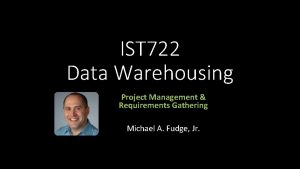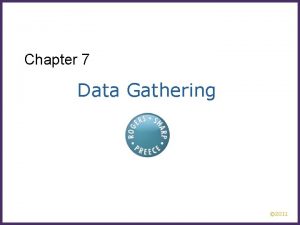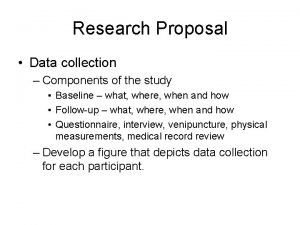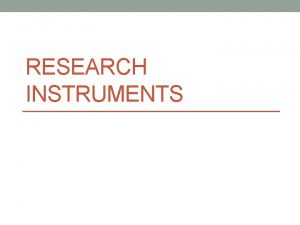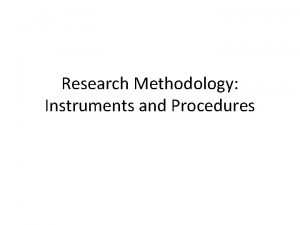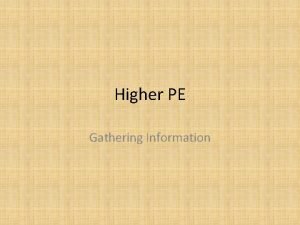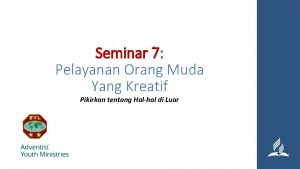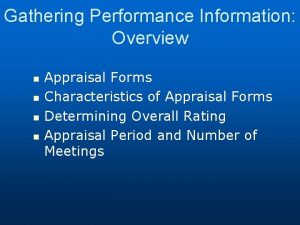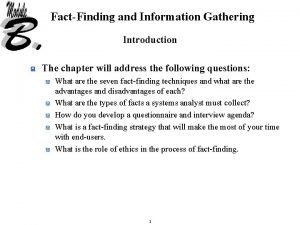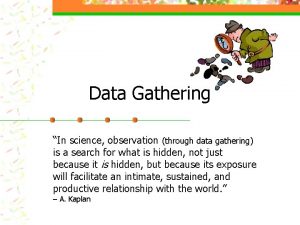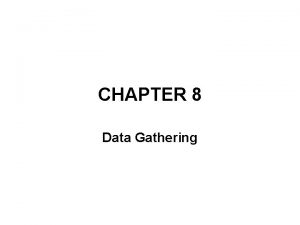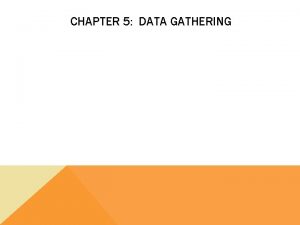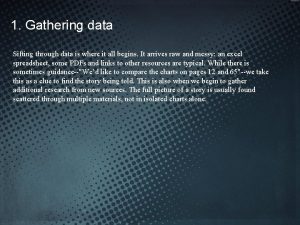DATA GATHERING What is Data Data is a





















- Slides: 21

DATA GATHERING • What is Data ? Data is a numerical expression of an activity. Conclusions based on facts and data are necessary for any improvement. -K. Ishikawa If you are not able to express a phenomenon in numbers, you do not know about it adequately. -Lord Kelvin

TYPES OF DATA Data if properly collected • Least influenced by individual biases • Could be subject to critical analysis • Generally beyond language barriers and therefore universal in expression.

WHAT IS THE DIFFERENCE BETWEEN A SHAFT DIAMETER THE NUMBER OF SHAFTS REJECTED FOR OVERSIZE DIAMETER The diameter of a shaft e. g. . 19. 055, 19. 0516 etc. . The number of shaft rejected has necessarily to be a whole number. e. g. . 0, 2, 7, 10 numbers rejected etc. . Data related to this type of parameters are called Discrete can take any value ever after the decimal point are Continuous data. called data.

HOW DO YOU DISTINGUISH BETWEEN CONTINUOUS AND DISCRETE CONTINUOUS • They are real numbers • Normally, they are measured values • They can not take a single value. There is an area associated with it • They are continuous • Requires less sample size DISCRETE • They are whole numbers • Normally, they are counted values • They can take only ‘Zero’ or non-fractional positive values • They are in steps of ‘ 1’ • Requires more sample size to have the more precision

WHICH OF THE BELOW ARE CONTINUOUS AND DISCRETE • Width of sheet DATA? • No. of liners thinned • Tubes rejected by Go- Nogo Gauge • Diameter of Piston • Height of a Man • Sheet thickness • Out of 100 sheets the numbers that meet the thickness 4 0. 9 • Time taken to process a purchase order • No. of bugs in a program

OBJECTIVES OF DATA COLLECTION • • To know and quantify the status To monitor the process To decide acceptance or rejection To analyse and decide the course of action HOW TO COLLECT DATA ? • • Define the purpose Decide the type of analysis Define the period of data collection Is the required data already available ?

FOR PROPER DATA COLLECTION. . . • Proper sampling procedure • Proper choice of instruments • Calibration of instruments used • Availability of standards for sensory characteristics • Adequate lighting and other test/inspection facilities. • Record all relevant information

WHAT IS VARIATION ? • No two things in nature alike. • This is also true for manufactured products. • This dissimilarity between two products for the same characteristic is called variation. • The variation may be or can be made to be so small so as to make the product SEEM similar. • When we say that 2 things are similar we actually mean that it is not possible to measure the variation present within the accuracy of the existing measuring equipment. • Variation between 2 products are compared for SIMILAR features or characteristics.

TYPES OF VARIATION • Variations among pieces at the same time • Variations across time

6. 55 6. 50 7. 00 6. 55 a. m. 5 minutes. This man wants to reach his work place by 6. 55 a. m. . But he can not do so, exactly at 6. 55 a. m. daily. Sometimes he reaches earlier (but almost never before 6. 50 a. m. ). Sometimes he reaches later (but almost never after 7. 00 a. m. ). WHY ?

THIS IS BECAUSE. . OF CERTAIN FACTORS WHICH • Affect the time he takes • He cannot control • Vary randomly e. g. The traffic you encounter under normal course of travel THE VARIATION THAT OCCURS DUE TO THESE KIND OF FACTORS IS CALLED INHERENT VARIATION OR COMMON CAUSE VARIATION OR WHITE NOISE. e. g. . m/c vibration, tool wear etc.

UNDER NORMAL SCHEME OF OPERATION Maximum deviation Aimed value Minimum deviation Inherent Variability (white noise)

TODAY HE IS EARLY ! WHY ? 6. 30 PROBABLY BECAUSE : • His watch was running fast. • He got a lift. • His bus driver took a shortcut. • He stayed over in the colony. • He had some important work to be finished before 7. 30. These causes are characteristic of a specific circumstance and do not occur in the normal scheme of actions. Variation due to these types of reasons is called assignable or special cause variation or black noise

GRAPHICAL DISPLAY OF VARIABILITIES CASE I Assignable (Black noise) Assignable Variability Inherent Variability Aimed Value Assignable Variability CASE III T O T A L V A R I A B I L I T Y

COMMON PROBLEMS WITH • Problems MEASUREMENTS with the measurements themselves 1. Bias or inaccuracy: The measurements have a different average value than a “standard” method. 2. Imprecision: Repeated readings on the same material vary too much in relation to current process variation. 3. Not reproducible: The measurement process is different for different operators, or measuring devices or labs. This may be either a difference in bias or precision. 4. Unstable measurement system over time: Either the bias or the precision changes over time. 5. Lack of resolution: The measurement process cannot measure to precise enough units to capture

DESIRED MEASUREMENT CHARACTERISTICS FOR CONTINUOUS VARIABLES 1. Accuracy Good repeatability if variation is small * Data from repeated measurement of same item The measured value has little deviation from the actual value. Accuracy is usually tested by comparing an average of repeated measurements to a known standard value for that unit. 2. Repeatability The same person taking a measurement on the same unit gets the same result.

DESIRED MEASUREMENT CHARACTERISTICS FOR CONTINUOUS VARIABLES 3. Reproducibility Other people (or other instruments or labs) get the same result you get when measuring the same item or characteristic. * Small relative to a) product variation and b) product tolerance (the width of the product specifications)

DESIRED MEASUREMENT CHARACTERISTICS FOR CONTINUOUS VARIABLES Time 1 Observed value Time 2 Observed value 4. Stability Measurements taken by a single person in the same way vary little over time. Good stability if difference is Small* * Small relative to a) product variation and b) product tolerance (the width of the product specifications)

DESIRED MEASUREMENT CHARACTERISTICS FOR CONTINUOUS VARIABLES 5. Adequate Resolution There is enough resolution in the measurement device so that the product can have many different values. Good if 5 or more distinct values are observed

IMPROVING A • A measurement system consists. SYSTEM of MEASUREMENT • Measuring devices • Procedures • Definitions • People • To improve a measurement system, you need to • Evaluate how well it works now (by asking “how much of the variation we see in our data is due to the measurement system? ”). • Evaluate the results and develop improvement strategies.

NOTE ON CALIBRATING MEASUREMENT EQUIPMENT • Measurement instruments should only be recalibrated when they show special cause evidence of drift. Otherwise, variation could be increased by as much as 40%. This is because adjusting for true common cause variation adds more variation (Deming’s rule 2 of the funnel). Measurements taken from stable instrument Measurements taken with stable instrument recalibrated before each reading
 Is interviews qualitative or quantitative
Is interviews qualitative or quantitative Data gathering procedure in research example
Data gathering procedure in research example Apa itu data requirement gathering
Apa itu data requirement gathering Data warehouse requirements gathering
Data warehouse requirements gathering Data gathering procedure
Data gathering procedure Five key issues of data gathering
Five key issues of data gathering Five key issues of data gathering
Five key issues of data gathering Data collection in research proposal
Data collection in research proposal Research instruments examples
Research instruments examples Methods of gathering data national 5 pe
Methods of gathering data national 5 pe 6.02 gathering weather data
6.02 gathering weather data Definition of terms in research
Definition of terms in research Data gathering procedure example
Data gathering procedure example Higher pe cycle of analysis
Higher pe cycle of analysis Ux requirements gathering
Ux requirements gathering Youth seminar topics
Youth seminar topics What is news gathering
What is news gathering Information gathering: interactive methods
Information gathering: interactive methods 9 major components of appraisal forms
9 major components of appraisal forms What is the setting of gathering blue
What is the setting of gathering blue Fact-finding questions examples
Fact-finding questions examples Eng in television
Eng in television



